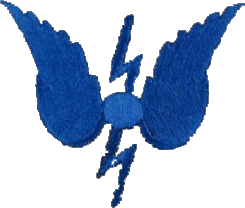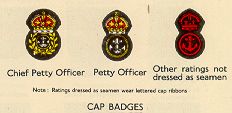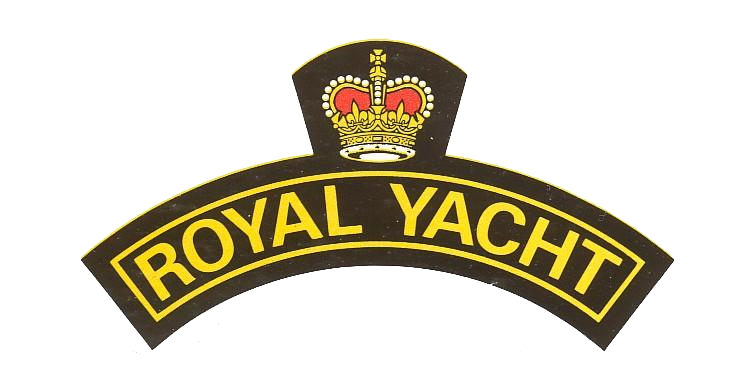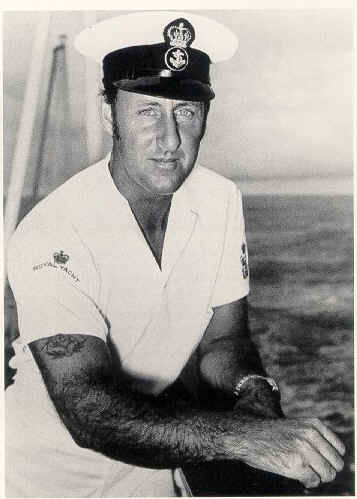


The Changing Face of Naval Ratings
Branch BadgesWritten by Godfrey Dykes© RN Communications Branch Museum/Library
<
During this period many of the branch badges proudly worn in 1930 had disappeared by 1980. See also all 325 ratings titles listed by HMS Centurion in 1970 by Ratings Titles. These changes reflected the changing technology of the times and the way the Navy organised itself to fight in the light of experience gained in the first world war and throughout the 1920's. The badges could well have been in use prior to 1930, and those shown in the 1977 Silver Jubilee Programme might still be extant post 1980. As a comparison, officers too [other than medical], lost their branch badges in the late 1950's, when the coloured bands inside their rings of rank ceased to be used. See Officers coloured bands.
As well as branch badges changing, three other events in rate/rank badges and uniform took place. In 1956, at the time of the Suez War, I was in the Flagship, HMS Tyne, actually anchored in Port Said. We had an SCO, Lieutenant Hugh Dickson, a Senior Commissioned Communications Officer [SCCO], Scutt, and 4 Commissioned Communications Officers [CCO], two of whom, were Tate and Drummond. Sub Lt SD[C] Tate was later to be involved in an altercation involving a knife in HMS Mercury, and Sub Lt Drummond SD[C] was later to be found dead in the Welsh mountains under suspicious circumstances. The CCO's thin branch-rank stripe was replaced by a thick one, thereby making them Sub Lieutenant's overnight. (see image to the left).
Simultaneously, the SCCO , who wore a thick ring, became a Lieutenant. At that time, all such officers became known as SD's, meaning Special Duties adding as a suffix the letter of the alphabet describing their speciality: for example Lieutenant H. Hornblower SD[C] Royal Navy, would be a commissioned communicator from the lower deck. In the 1970's, supply and secretarial ratings [and in other times, other ratings like Coders for example] who had never been dressed in the square-rig like other ratings, lost their privilege of wearing fore and aft rig, modified by having black bone buttons instead of gilt buttons, and a cap badge which was red in colour and lacked the other colours to be found on PO's, and CPO's cap badges.

From that time on, they wore square-rig until promoted to petty officer. Finally, 1972 saw the reintroduction of the Warrant Officer, but brought back as a rate and not a rank for non commissioned officers [the commissioned warrant officer rank ended in 1949] , and many years after 1972, they were allowed to call themselves Warrant Officers. The whole of the introductory period [approximately two years] was a farce, and ill thought out by the Admiralty. At first. FCPO's kept their Chief's buttons on each cuff and wore just one warrant officers badge. Then, the buttons were taken away leaving just the one badge. Finally, a second badge was allowed, one on each cuff. From 1972 to certainly 1983 when I left the service, they were called Fleet Chief Petty Officers as a group, and individually, by their rating/branch title: mine for example was Fleet Chief Radio Supervisor (FCRS).
Notice the King's Crown on the badges, as opposed to a Queen's Crown used in 1953, and of course in todays [2003] Navy. On that sad day of the death of Her Majesty, all the buttons will have to be changed to show a King's Crown. However, I am using what was commonly believed but for the correct terminology see this story What should happen to Naval Uniforms.
The table below show the badges listed in the 1937 Coronation Review of the Fleet at Spithead by HM King George VI on the 20th May 1937, but are known to have been in use earlier in the 1930's.
If you click the SENIOR badge of the branch you are interested in (those with a yellow background e.g. 22 for Telegraphist: 1 for Gunnery etc) you will be taken to a page giving details of what was published in the Coronation Review for HM Queen Elizabeth on the 15th June 1953 and in the Fleet Review to celebrate Her Majesty's Silver Jubilee on the 28th June 1977.
© RN Communications Branch Museum/Library
<During this period many of the branch badges proudly worn in 1930 had disappeared by 1980. See also all 325 ratings titles listed by HMS Centurion in 1970 by Ratings Titles. These changes reflected the changing technology of the times and the way the Navy organised itself to fight in the light of experience gained in the first world war and throughout the 1920's. The badges could well have been in use prior to 1930, and those shown in the 1977 Silver Jubilee Programme might still be extant post 1980. As a comparison, officers too [other than medical], lost their branch badges in the late 1950's, when the coloured bands inside their rings of rank ceased to be used. See Officers coloured bands.
As well as branch badges changing, three other events in rate/rank badges and uniform took place. In 1956, at the time of the Suez War, I was in the Flagship, HMS Tyne, actually anchored in Port Said. We had an SCO, Lieutenant Hugh Dickson, a Senior Commissioned Communications Officer [SCCO], Scutt, and 4 Commissioned Communications Officers [CCO], two of whom, were Tate and Drummond. Sub Lt SD[C] Tate was later to be involved in an altercation involving a knife in HMS Mercury, and Sub Lt Drummond SD[C] was later to be found dead in the Welsh mountains under suspicious circumstances. The CCO's thin branch-rank stripe was replaced by a thick one, thereby making them Sub Lieutenant's overnight. (see image to the left).
Simultaneously, the SCCO , who wore a thick ring, became a Lieutenant. At that time, all such officers became known as SD's, meaning Special Duties adding as a suffix the letter of the alphabet describing their speciality: for example Lieutenant H. Hornblower SD[C] Royal Navy, would be a commissioned communicator from the lower deck. In the 1970's, supply and secretarial ratings [and in other times, other ratings like Coders for example] who had never been dressed in the square-rig like other ratings, lost their privilege of wearing fore and aft rig, modified by having black bone buttons instead of gilt buttons, and a cap badge which was red in colour and lacked the other colours to be found on PO's, and CPO's cap badges.

From that time on, they wore square-rig until promoted to petty officer. Finally, 1972 saw the reintroduction of the Warrant Officer, but brought back as a rate and not a rank for non commissioned officers [the commissioned warrant officer rank ended in 1949] , and many years after 1972, they were allowed to call themselves Warrant Officers. The whole of the introductory period [approximately two years] was a farce, and ill thought out by the Admiralty. At first. FCPO's kept their Chief's buttons on each cuff and wore just one warrant officers badge. Then, the buttons were taken away leaving just the one badge. Finally, a second badge was allowed, one on each cuff. From 1972 to certainly 1983 when I left the service, they were called Fleet Chief Petty Officers as a group, and individually, by their rating/branch title: mine for example was Fleet Chief Radio Supervisor (FCRS).
Notice the King's Crown on the badges, as opposed to a Queen's Crown used in 1953, and of course in todays [2003] Navy. On that sad day of the death of Her Majesty, all the buttons will have to be changed to show a King's Crown. However, I am using what was commonly believed but for the correct terminology see this story What should happen to Naval Uniforms.
The table below show the badges listed in the 1937 Coronation Review of the Fleet at Spithead by HM King George VI on the 20th May 1937, but are known to have been in use earlier in the 1930's.
If you click the SENIOR badge of the branch you are interested in (those with a yellow background e.g. 22 for Telegraphist: 1 for Gunnery etc) you will be taken to a page giving details of what was published in the Coronation Review for HM Queen Elizabeth on the 15th June 1953 and in the Fleet Review to celebrate Her Majesty's Silver Jubilee on the 28th June 1977.
Simultaneously, the SCCO , who wore a thick ring, became a Lieutenant. At that time, all such officers became known as SD's, meaning Special Duties adding as a suffix the letter of the alphabet describing their speciality: for example Lieutenant H. Hornblower SD[C] Royal Navy, would be a commissioned communicator from the lower deck. In the 1970's, supply and secretarial ratings [and in other times, other ratings like Coders for example] who had never been dressed in the square-rig like other ratings, lost their privilege of wearing fore and aft rig, modified by having black bone buttons instead of gilt buttons, and a cap badge which was red in colour and lacked the other colours to be found on PO's, and CPO's cap badges.

From that time on, they wore square-rig until promoted to petty officer. Finally, 1972 saw the reintroduction of the Warrant Officer, but brought back as a rate and not a rank for non commissioned officers [the commissioned warrant officer rank ended in 1949] , and many years after 1972, they were allowed to call themselves Warrant Officers. The whole of the introductory period [approximately two years] was a farce, and ill thought out by the Admiralty. At first. FCPO's kept their Chief's buttons on each cuff and wore just one warrant officers badge. Then, the buttons were taken away leaving just the one badge. Finally, a second badge was allowed, one on each cuff. From 1972 to certainly 1983 when I left the service, they were called Fleet Chief Petty Officers as a group, and individually, by their rating/branch title: mine for example was Fleet Chief Radio Supervisor (FCRS).
Notice the King's Crown on the badges, as opposed to a Queen's Crown used in 1953, and of course in todays [2003] Navy. On that sad day of the death of Her Majesty, all the buttons will have to be changed to show a King's Crown. However, I am using what was commonly believed but for the correct terminology see this story What should happen to Naval Uniforms.
The table below show the badges listed in the 1937 Coronation Review of the Fleet at Spithead by HM King George VI on the 20th May 1937, but are known to have been in use earlier in the 1930's.
If you click the SENIOR badge of the branch you are interested in (those with a yellow background e.g. 22 for Telegraphist: 1 for Gunnery etc) you will be taken to a page giving details of what was published in the Coronation Review for HM Queen Elizabeth on the 15th June 1953 and in the Fleet Review to celebrate Her Majesty's Silver Jubilee on the 28th June 1977.
The following badges were shown in the 1953 Fleet Review programme but not in the 1937 programme.
 |
Boom Defence. In 1977 programme, same badge shown as "SEAMAN". See Note below. |
 |
Naval Airman and Naval Airman (S.A.M). Top picture of aircraft repeated in 1977 programme. 1. With aircraft badge. Aircraft Handler = H: Safety Equipment = SE: Fitter and Mechanic A = A: Fitter and Mechanic E = E: Fitter and Mechanic O = O: Met Observer = MET: Photographer = P. 2. With two-bladed propeller. Naval Airman [S.A.M] [A] = R: Naval Airman [S.A.M] [E] = F: Naval Airman [S.A.M] [O] = O. Pilots' Mates wear their two-bladed propellers on the right cuff in addition to their branch badges on the right arm. All these badges have the relevant letter underneath the badge. |
 |
See Note below. |
 |
Electrical. Shown as "WEAPONS AND ELECTRICAL" in the 1977 programme. The relevant letter is worn in the centre of the badge. Electrical Branch letters. Electrician = L: Electrical Air = AL: Radio Electrician = R: Radio Electrician Air = AR. Alma Mater = HMS Collingwood Fareham Hampshire. See Note below |
 |
Radar Plot Branch. Badge repeated in 1977 programme but now called "Radar, Radar [Submarine] and Electronic Warfare".
See Note below.
This is the gunnery branch badge. Imagine deleting the crossed guns and replacing them with your PPI branch badge. Then you would see the Radar Branch badge throughout all rates.
 C.P.O., P.O., and confirmed Leading Ratings qualified as Gunnery, T and AS, Radar Plot, Wireless, Signalling Instructors and Staff Physical and Recreational Training Instructors wear a crown and two stars.
Alma Mater: HMS DRYAD Southwick Portsmouth Hampshire. Dryad comes from Greek and Roman mythology meaning a nymph who inhabits trees.
C.P.O., P.O., and confirmed Leading Ratings qualified as Gunnery, T and AS, Radar Plot, Wireless, Signalling Instructors and Staff Physical and Recreational Training Instructors wear a crown and two stars.
Alma Mater: HMS DRYAD Southwick Portsmouth Hampshire. Dryad comes from Greek and Roman mythology meaning a nymph who inhabits trees. |
 |
Sailmaker. No mention in 1977 programme. See Note below. |
New picture introduced in the 1977 programme, not found elsewhere. |
|
 |
Mine WarfareSee note below. |
NOTE |
|
SPECIALIST BADGES





















































